[this is a VERY long write-up of four days I spent in Demark last week. Hopefully it’ll be worth the effort]
-o0o-
From whence cometh inspiration?
No idea. Not a clue.
I really don’t have a handle on where inspiration actually comes from. Or what it actually is.
But I do know that I can massively increase the chances of stumbling into it by surrounding myself with curious people, especially those who are working in fields other than my own.
Being primarily an instrumentalist, I’m constantly working with an abstract/concrete duality. The purpose/message/inspiration of a particular piece may be concrete, but the interpretation – if it happens without some kind of written/spoken introduction – is at best culturally mediated and often entirely abstract. That so many people seem to hear something of my intention in my music is itself an amazing affirmation that I’m not insane to see it as having a ‘purpose’.
What’s this got to do with the 2nd Inspiration Lab at Cantabile 2 in Stege, Denmark?
Well, everything. The limits of my own musical practice are always where the interesting stuff happens. I’m interested in edge spaces, overlaps, the bits where the circles in the Venn diagram of humanity change colour as they overlap in different combinations.
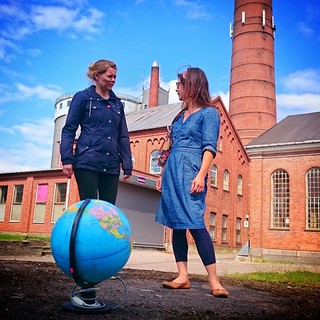 In the arts, we often gravitate towards influences and influencers who can obviously help shape our own work. Songwriters get into other word disciplines easily, musicians who make records are inspired by films – time delineated documents of a series of events, easy to mulch into a musical expression of a similar aesthetic… it’s often the music in the film that starts the process anyway…
In the arts, we often gravitate towards influences and influencers who can obviously help shape our own work. Songwriters get into other word disciplines easily, musicians who make records are inspired by films – time delineated documents of a series of events, easy to mulch into a musical expression of a similar aesthetic… it’s often the music in the film that starts the process anyway…
But what happens when those disciplines are a less obvious match? What happens when film makers think like architects? When a rapper uses a painting as her point of origination? When a graphic designer with a heavy emphasis on typography sits down with a classical actor, itching to stretch the boundaries of their own work?
It creates spaces where inspiration can flourish. I don’t think it is ‘inspiration’ itself in any substantially meaningful way. The conversations can be frustrating and tedious, points can be missed, potential unexplored, but given the right framing, these cross-disciplinary conversations about how and why we do what we do – about process – can be incredible fertile.
And that’s what happened in Stege.
How did I end up there? Good question, internal-monologue, good question.
 It started with meeting a London-based theatre maker called Annette Mees. Actually, it didn’t, it started a long time before that, but we’ll start there and work backwards. When I met Annette and discovered we had a few friends in common, we started talking about what we were working on. She described the upcoming ‘creative lab looking at cross disciplinary process’ and I wondered if she’d be reading my email… see, I sketched out a rough idea for an event on the same theme a few years back, with my Scottish friend and source of huge inspiration, Roanne Dods. I just wanted to create a space where people could talk about what they do, how they do it, why they do it. Process rather than product. Not getting too bogged down in the output, but more thinking about how someone else’s journey could change our journey.
It started with meeting a London-based theatre maker called Annette Mees. Actually, it didn’t, it started a long time before that, but we’ll start there and work backwards. When I met Annette and discovered we had a few friends in common, we started talking about what we were working on. She described the upcoming ‘creative lab looking at cross disciplinary process’ and I wondered if she’d be reading my email… see, I sketched out a rough idea for an event on the same theme a few years back, with my Scottish friend and source of huge inspiration, Roanne Dods. I just wanted to create a space where people could talk about what they do, how they do it, why they do it. Process rather than product. Not getting too bogged down in the output, but more thinking about how someone else’s journey could change our journey.
So, I got the details from Annette and applied to be a participant in Stege. I successfully managed to leave my expectations of that previous event idea behind – my interpretation of any idea is rarely the best one, and I was eager to see what Annette would come up with.
The event itself ended up being four days of making things. Those ‘things’ ranged from games to installations, theatrical tableaus, short enigmatic live art pieces and one piece of participatory narrative theatre built around an imagined space journey. We made intentionally ‘bad’ art, we moved WELL outside our comfort zones, we got to moonlight in other people’s disciplines and we all got to draw on our expertise to make surprising and exciting work in a very short space of time.
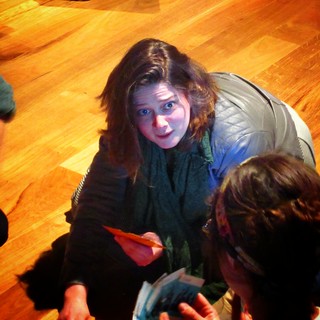 Annette surfed the role of facilitator with a level of apparent ease that belied the fact that she was actually very ill for the first two days… I wonder how her involvement in the actual making would’ve differed had she not been in such a bad way… As it was, she compensated perfectly for her own fragility by winding things up and letting them go. I, as a rule, *hate* being facilitated. I’m not a fan of the artifice and generally get annoyed that I can’t just sit and talk to all these interesting people I’m in a room with. But this was perfect. Each set up was open ended enough – intentionally leaving loads of questions for us to deal with – for us to make interesting, diverse work and get to know each other really well through the process.
Annette surfed the role of facilitator with a level of apparent ease that belied the fact that she was actually very ill for the first two days… I wonder how her involvement in the actual making would’ve differed had she not been in such a bad way… As it was, she compensated perfectly for her own fragility by winding things up and letting them go. I, as a rule, *hate* being facilitated. I’m not a fan of the artifice and generally get annoyed that I can’t just sit and talk to all these interesting people I’m in a room with. But this was perfect. Each set up was open ended enough – intentionally leaving loads of questions for us to deal with – for us to make interesting, diverse work and get to know each other really well through the process.
So what did you make, Steve? Hang on, I’m getting to that… anyway, here’s what I actually did during my time there.
First thing was, I discovered I’m quite good at ‘games’. I’m not a gamer at all. Gaming is not a frame through which I usually view things. Play is, but the rules and interactions of gaming (and the influence of competition and trying to win) has always put me off. However, in a number of the game set-ups my interest in understanding and playing the game well, as opposed to any attempt to ‘win’ the game, made me quite good at them. That was interesting.
 We had to choose a familiar old game, and change a rule to make it different… My group chose to mash up ‘grandma’s footsteps’ (that thing where one of you faces away, everyone creeps up on them, but if they turn round and see you moving you’re out) with Kabaddi (an Indian game that requires all the people on the team side of it to hold hands…) The resulting game was a lot of fun, but we soon found that there were now strategic ways to make it worse for other people, or to do basically nothing and still win… A really interesting way to tackle a problem.
We had to choose a familiar old game, and change a rule to make it different… My group chose to mash up ‘grandma’s footsteps’ (that thing where one of you faces away, everyone creeps up on them, but if they turn round and see you moving you’re out) with Kabaddi (an Indian game that requires all the people on the team side of it to hold hands…) The resulting game was a lot of fun, but we soon found that there were now strategic ways to make it worse for other people, or to do basically nothing and still win… A really interesting way to tackle a problem.
The first bit of ‘work’ that I helped make was the aforementioned space adventure. In looking for an outdoor space in which to do *something*, along with Laura and Alison we decided to do a journey – to use the environment of disused factories and create a story. We had a prop each (a globe, a kids’ bike and a walking stick) that needed to be in it somewhere, we added a bit that the audience needed to complete to ‘save the world’ at the end. We told a story, took the people we were making the piece for (a specific audience of four people we knew a tiny bit about) on a journey, made it absurd… We’d talked about the Crystal Maze in the planning of it, so I hammed up my little bit of acting at the end, to not particularly good effect… We took inspiration from various sources (I told the story of playing ‘fake histories’ with my God-daughter in the British Museum, which entails filming her narrating an entirely made up documentary about the stuff we’re looking at) and came up with an adventure
Then another group had to make a piece for us – we were the select audience, and were part of a little installation/experience piece called The Silence Of The Rain, built around a soundscape centred on a boiling kettle. We were lying on the floor, surrounded by evocative sounds, until the kettle finished boiling. Really interesting.
We then got to remix that. Each group got to remake the thing they’d be a part of. A lovely way of looking at repurposing ideas, at applying the experience of being in the audience to the task of improving a work. It was also a really interesting way of thinking about what ‘the work’ was. The score for the new piece was the collective memory of the experience of it in the minds of its audience, who then got to play that score… Crazy fun!
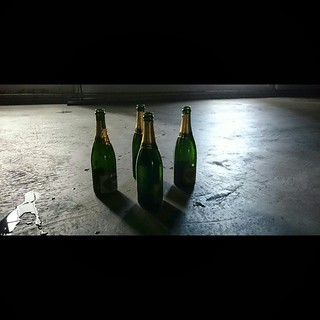 Our remix of that particular piece reoriented it so the audience were lying under a table, and the majority of the sound creation happened on the table, using it as a resonant sounding board. It also happened in the dark. It was – notably – the first time I’d performed an acoustic show with an electric bass, using the table as a sounding board, blending the sound of a two note ostinato and some open harmonics with the sound of the kettle boiling, chains being dragged over the table and a giant sword being dragged around the floor of the room… Apparently it made for a really interesting and immersive experience. Another interesting process intervention: making work you’ll never get to experience (we weren’t in any position to trial it, so everything was planned and then improvised in the moment). There was no way of recording it for future experience, as being under the table was pretty central to what made it work…
Our remix of that particular piece reoriented it so the audience were lying under a table, and the majority of the sound creation happened on the table, using it as a resonant sounding board. It also happened in the dark. It was – notably – the first time I’d performed an acoustic show with an electric bass, using the table as a sounding board, blending the sound of a two note ostinato and some open harmonics with the sound of the kettle boiling, chains being dragged over the table and a giant sword being dragged around the floor of the room… Apparently it made for a really interesting and immersive experience. Another interesting process intervention: making work you’ll never get to experience (we weren’t in any position to trial it, so everything was planned and then improvised in the moment). There was no way of recording it for future experience, as being under the table was pretty central to what made it work…
 Next up was making intentionally bad art. Which is REALLY hard! Especially amongst a group that has formed around a collective experience of trust and the creation of a safe space to experiment. Friendships were forming and personalities emerging thus the ‘danger’ with any bad work was that it just became ‘so bad it’s good’. So we tried to make confused, terrible, boring work. But as predicted most of it turned out funny. One piece ended up being one of the funniest things I’ve seen in a long time. Like, clutching your stomach laughing funny.
Next up was making intentionally bad art. Which is REALLY hard! Especially amongst a group that has formed around a collective experience of trust and the creation of a safe space to experiment. Friendships were forming and personalities emerging thus the ‘danger’ with any bad work was that it just became ‘so bad it’s good’. So we tried to make confused, terrible, boring work. But as predicted most of it turned out funny. One piece ended up being one of the funniest things I’ve seen in a long time. Like, clutching your stomach laughing funny.
Then came what may end up being the most important conversation of the entire event for me. A discussion with Hannes (Iceland actor) and Ingrid (Danish photographer) about what we could do to be truly ‘bad’. We decided it would have to be offensive. Not comically so, just horrifically, gut wrenchingly foul, but badly done. This resulted in a 20 minute conversation of horror-one-up-manship. The story getting worse, the scenery more terrible, the list of taboos being broken longer and longer. It played out like a remix of ‘The Aristocrats!’ joke. See just how horrible you can be, but with the added impetus to stage it in a really crass way, and incorporate as much first-year-drama-student bad surrealism as possible…
Then came the killer line. Just as we’d finished devising this despicable, unperformable work, Knud – a sound designer, composer and generally delightful human being from Denmark turned to us and said ‘just burn a dog’. No exclamation mark. No shock, just a single line that would make for a show more offensive, more horrible, and much worse artistically than our 20 minutes of fussy point-scoring offensiveness.
‘just burn a dog’.
Again, I cried laughing for about 20 minutes. Literally unable to speak. Definitely in the top 3 or 4 funniest things I’ve ever heard in my life, entirely dependent on having spent the previous 20 minutes in conversation about this terrible thing and having that bubble burst so spectacularly.
But also, it was UTTERLY profound. That level of ability to cut through fussy bullshit, to dig beneath the layers of box-ticking ‘impact’ of a show, of a work, of a piece of music, of the staging of a work, and realise that all you needed to do was burn a dog.
So now, the question for me is always ‘where’s the burning dog?’ what is that thing? It may well be that the fussy version is the thing that needs to happen – be as simple as you have to be, but no simpler. There are aesthetic worlds that require a level of complexity and specification to have their meaning, to do their job. But often, the quest for the burning dog will uncover a whole other kind of story.
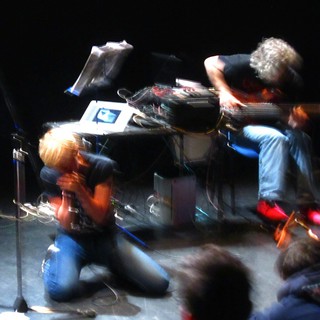 As an example, I think Torycore is a burning dog – doing an anti-austerity theatre piece could get really complex. You could legitimately go through endless scenarios for how best to tell the story of those who are marginalised, tormented, made powerless by the austerity agenda and the machine of power that enacts it. But the burning dog is just to put their words to a soundtrack that reflects the horror and rage. No editorialising, no characters, no fictive script. Just three people getting really fucking angry and doing it at very high volume. A simple shock to the system. It’s not easy to do, but the idea is just
As an example, I think Torycore is a burning dog – doing an anti-austerity theatre piece could get really complex. You could legitimately go through endless scenarios for how best to tell the story of those who are marginalised, tormented, made powerless by the austerity agenda and the machine of power that enacts it. But the burning dog is just to put their words to a soundtrack that reflects the horror and rage. No editorialising, no characters, no fictive script. Just three people getting really fucking angry and doing it at very high volume. A simple shock to the system. It’s not easy to do, but the idea is just
Words, guitars, screaming.
…
Dog, match, lighter fluid.
The next exercise was to make a piece that used the expertise of the people in your (new) group. Mine included Christian – a remarkable man who makes machines, robots, explosions. I think I described what he does as parkour with objects and physics. He has a totally different way of looking at stuff in a room. He sees things that connect, that move, that interact, that can be repurposed, and more often that not, used to make things explode. And Hannah – a photographer, theatre manager and graphic designer, with a fascinating take on the relationship between ideas and images, music and pictures…
So we set about making a thing where Christian created sparks and crazy explosive noises in a coffee pot, and I sampled it. He stripped the bare wire on an electrical cable, plugged it in and stuck it in water. Nothing. Water doesn’t conduct, see? It needs an additive. He started out by soaking some microwave popcorn in water to get the salt off it (THAT’S HOW HE THINKS!!) then switched to hydrochloric acid for the performance. Meanwhile Hannah was pushing me to play more, create more music for her to represent visually. She immediately latched onto the layered, patterned, interlocking nature of looping, and started to photograph the details of the room, of my music gear, of the space to pull together a textural collage. I saw this, and decided against the big melodic spacey melodic stuff that had been part of my development process over the sampled sparks and electrical noises… They didn’t fit her images, so I went back to textures and patterns. Processing, playing, linking the shining glittering sparks to the textural photos… it was the beginnings of something beautiful. It was a bit scrappy, and we hadn’t given much thought to staging, to how the audience would see it, but we had an idea that ended up in bits on the wall of ideas.
The Wall Of Ideas? that sounds grand…
Ah, yes, the wall of ideas – anything that came from any of the ideas that people liked ended up on the wall of ideas to be remixed, repurposed, reimagined. Our piece of ‘bad art’ happened in the women’s toilets. That ended up on the wall of ideas and two much much better pieces ended up staged in there. We’d never have done that without the permission to explore ‘bad’ ideas and discover they were really good.
So the things on the wall of ideas built towards a final set of work that would be made and for which there would be an outside audience. We didn’t really make it ‘for’ them, but they would be a factor in how it all played out. We were able to think about the experience of this work for people who weren’t in on the joke, who weren’t already attached to the journey that got us there… We broke off, started to form groups ourselves, exploring the various spaces available, having conversations about possible work. About 90 minutes of talking happened. Everyone disappearing into the exploration of the possible, rather than the process we’d had for the last few days of making/remaking/remixing/rethinking. A group discussion after lunch expertly guided by Annette pulled us right back to that place. Brilliant Ken (that’s not his name, well Ken is, but Brilliant is what he is, not evidence of strange parents) reintroduced permission for good talking vs bad talking, and we were off. I went through four or five possible layers of involvement. Exploring the idea of connecting three of the spaces with a single soundscape (looking for something to stretch me! Just playing bass would never have done that…) and ended up being invited to be part of a conversation about work in the big room. The big room was a massive warehouse space with glorious natural light, reverberant acoustics, and a robust make-up that meant you could do big bold physical things in it. It has already hosted a number of large scale bits of work in various states of being made/unmade/explored, and many of those ideas, via the Wall Of Ideas were being remixed into a final piece.
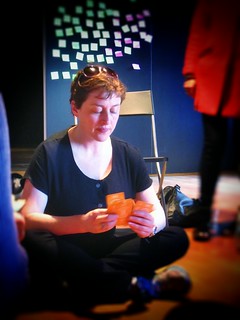 One of them had been a particularly successful experiment in water-painting. Splashing huge quantities of water on the floor, positioning the audience where the reflection of the natural light was strongest, and then improvising the drawing of lines and shapes with the water – initially with feet, then via champagne bottles pouring out more water, and then brooms-as-giant-brushes. It had been a particularly pleasing experiment first time round and there was an eagerness to try it again, but then came the comfort. Just doing it once more was too easy, too beautiful. How to break it? Mia – a theatre director who had bold ideas and was willing to throw them in as disruption-bombs came up with a whole load of really useful ideas for how to incorporate the audience into the work. We then looked at how to remix what they had done, and I suggested light as the next layer… It had been really useful to consider my musical process in non-audio terms over the previous couple of days. Thinking about layering, processing, remixing… It was something that had come up in that very first conversation with Annette, when we spotted a load of similarities in our processes and purposes despite the massive difference in context… so how to layer/remix the light on top of the water? Mirrors, spotlights, movement… all considered, explored. And discarded. BUT a whole new layer of thinking about light emerged, and sound was brought back in. The original soundscape for the first version of the piece had Knud constructing a soundtrack beforehand with scraping feet and splashing water, accompanied by live drumming… I could do that in real time with the looping set-up. It would make for a nice bit of theatre too, me scurrying around with a mic on a massive cable…
One of them had been a particularly successful experiment in water-painting. Splashing huge quantities of water on the floor, positioning the audience where the reflection of the natural light was strongest, and then improvising the drawing of lines and shapes with the water – initially with feet, then via champagne bottles pouring out more water, and then brooms-as-giant-brushes. It had been a particularly pleasing experiment first time round and there was an eagerness to try it again, but then came the comfort. Just doing it once more was too easy, too beautiful. How to break it? Mia – a theatre director who had bold ideas and was willing to throw them in as disruption-bombs came up with a whole load of really useful ideas for how to incorporate the audience into the work. We then looked at how to remix what they had done, and I suggested light as the next layer… It had been really useful to consider my musical process in non-audio terms over the previous couple of days. Thinking about layering, processing, remixing… It was something that had come up in that very first conversation with Annette, when we spotted a load of similarities in our processes and purposes despite the massive difference in context… so how to layer/remix the light on top of the water? Mirrors, spotlights, movement… all considered, explored. And discarded. BUT a whole new layer of thinking about light emerged, and sound was brought back in. The original soundscape for the first version of the piece had Knud constructing a soundtrack beforehand with scraping feet and splashing water, accompanied by live drumming… I could do that in real time with the looping set-up. It would make for a nice bit of theatre too, me scurrying around with a mic on a massive cable…
 So we explored that – in and out of my comfort zone at the same time. Easy process (recording/looping/processing/layering… no sweat) but different aesthetic considerations. Eventually I realised that I needed to take those sounds and add me. Play some bass to it, mangle the feet and water samples… Christian was the next stage in the process, redoing the sparks-in-water piece, so that added more samples to the work, and finally the sound of barrels being rolled and spun on the floor. The barrels had been played as tribal drums for the first version, now they got re-employed in some kind of surreal live action Donkey Kong dance. bouncing across the floor, chased by me with a mic. Build enough of a soundscape, tie all the elements together sonically, then play over it, have it descend into a massive cloud of ambient goo in that beautiful space.
So we explored that – in and out of my comfort zone at the same time. Easy process (recording/looping/processing/layering… no sweat) but different aesthetic considerations. Eventually I realised that I needed to take those sounds and add me. Play some bass to it, mangle the feet and water samples… Christian was the next stage in the process, redoing the sparks-in-water piece, so that added more samples to the work, and finally the sound of barrels being rolled and spun on the floor. The barrels had been played as tribal drums for the first version, now they got re-employed in some kind of surreal live action Donkey Kong dance. bouncing across the floor, chased by me with a mic. Build enough of a soundscape, tie all the elements together sonically, then play over it, have it descend into a massive cloud of ambient goo in that beautiful space.
It worked! Sort of. There were bits where the soundtrack was too loud given where people were in the space, but the visual elements were so strong, the water was beautiful, people spontaneously joined in with the painting and the barrel spinning. We projected Hannah’s textural pictures onto Christian while he was doing the sparks, which looked lovely… So many things combined from the wall of ideas.
By this point, we’d come to the point you hope to reach in a team like that – where ‘cross-disciplinary’ is meaningless. Everyone is just making. Creating, employing their expertise but using the lens of others work and ideas to contribute in unexpected ways. Through the time there I got to think about lighting, staging, mirrors, narrative, electronics, installations, live art, meaning, abstraction… Alongside Annette’s facilitated sessions, we had things hosted by the participants – from Christian’s “ideas toolkitâ€, I discovered that a lot of my process thinking is about opposites, finding the dialectic conversation at the heart of an idea. This vs that, this position vs it’s opposite point. The similarities are a given, let’s explore how far it can be pushed. Once I’d seen it, it was evident in loads of my work.
 I’ve never stuck to one thing. I’m an instrumentalist who lives in a world of words. My 2nd ever ‘band’ was a project that just made weird noises into a tape deck – running taps, rustling bags, to build comedy soundscapes. My first ever solo gig was accompanying a site-specific dance piece in a car park in East London. At school I was an actor. As a 5 year old, I wrote plays and then acted them out with my friends in the street for the neighbours to watch. I wrote a novel in a month. I’ve worked as a journalist for much of the last 18 years. I’m an award winning app developer (for an app that was never finished). I’ve had positive gig reviews from critics who didn’t like the music but thought the talking/comedy part was enough to recommend the show anyway! …Music just emerged as the thing that piqued my curiosity the most. Where those opposites were move evident and explorable. The dialectical tension between the expected role of the bass and its potential as a complete sound world. Despite songs being my primary source of inspiration, I ended up playing mostly instrumental music… So my work and ideas are deeply rooted in cross disciplinary thinking.
I’ve never stuck to one thing. I’m an instrumentalist who lives in a world of words. My 2nd ever ‘band’ was a project that just made weird noises into a tape deck – running taps, rustling bags, to build comedy soundscapes. My first ever solo gig was accompanying a site-specific dance piece in a car park in East London. At school I was an actor. As a 5 year old, I wrote plays and then acted them out with my friends in the street for the neighbours to watch. I wrote a novel in a month. I’ve worked as a journalist for much of the last 18 years. I’m an award winning app developer (for an app that was never finished). I’ve had positive gig reviews from critics who didn’t like the music but thought the talking/comedy part was enough to recommend the show anyway! …Music just emerged as the thing that piqued my curiosity the most. Where those opposites were move evident and explorable. The dialectical tension between the expected role of the bass and its potential as a complete sound world. Despite songs being my primary source of inspiration, I ended up playing mostly instrumental music… So my work and ideas are deeply rooted in cross disciplinary thinking.
But…there was SO much to discover in the process Annette facilitated in Stege. So many new ideas, new perspectives, and such a truly brilliant context in which to do it. Knowing Annette already meant I went with some expectation, but it ended up being nothing like I would’ve expected, and so much more as a result. I’ve got a whole new list of heroes, of people to channel, of potential collaborators for future projects, of people to Skype when I get stuck… I hope they all see me as that too.
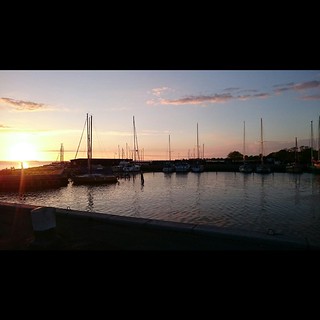 And I’ve now got the task of bringing all that learning – all that curiosity, fun, playful thinking – to my world as a musician, as a solo artist, as a deviser of concerts… I need to mess with the terminology around what I/we do, because gigs are such an astonishingly mundane set-up. It’s not that magic can’t happen there – so many of my favourite times ever have been listening to live music – but it’s so rare for anyone to properly rethink the context for live music, to recontextualise it, to find it a new home, a new purpose, to tell different stories with it, to involve the audience in interesting ways, to bring other stimuli to the process of making the music in the first place. The Inspiration Lab provided buckets and buckets of inspiration for that process, as well as setting me off in search of the burning dog of solo bass…
And I’ve now got the task of bringing all that learning – all that curiosity, fun, playful thinking – to my world as a musician, as a solo artist, as a deviser of concerts… I need to mess with the terminology around what I/we do, because gigs are such an astonishingly mundane set-up. It’s not that magic can’t happen there – so many of my favourite times ever have been listening to live music – but it’s so rare for anyone to properly rethink the context for live music, to recontextualise it, to find it a new home, a new purpose, to tell different stories with it, to involve the audience in interesting ways, to bring other stimuli to the process of making the music in the first place. The Inspiration Lab provided buckets and buckets of inspiration for that process, as well as setting me off in search of the burning dog of solo bass…

